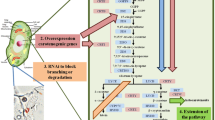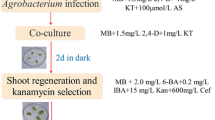Abstract
A corn (Zea mays L.) mutant, blue fluorescent-1 (bf), is described that shows ultraviolet light induced blue fluorescence in young seedling leaves if homozygous for the mutant gene, and in anthers if either homozygous or heterozygous. The blue fluorescent compounds were extracted with acetone and separated by paper chromatography. Anthranilic acid was present and the β-glucoside was also identified by paper chromatography and β-glucosidase and acid treatment. A third major fluorescent compound was not identified, but it was convertible to anthranilic acid by acid treatment. Anthranilate synthetase from mutant plants was 3–40 times more active and was also more resistant to feedback inhibition by tryptophan than was the enzyme from normal plants. The high activity and feedback resistance would both lead to anthranilate accumulation. Anthranilate-phosphoribosylpyrophosphate phosphoribosyltransferase (PR transferase), the enzyme which usually utilizes anthranilate in the tryptophan pathway, was inhibited by the β-glucoside of anthranilic acid in a noncompetitive manner and showed very little activity in the mutant plant extract. This inhibition of the enzyme which utilizes anthranilate would also lead to accumulation. Apparently the oversynthesis of anthranilate leads to the formation of the β-glucoside, which inhibits anthranilate utilization. The fluorescent compounds are absent in seed, but form on germination. The levels decrease with age after 35 days postgermination, but are still present in leaves during grain filling.
Similar content being viewed by others
References
Belser, W. L., Murphy, J. B., Delmer, D. P., and Mills, S. E. (1971). Endproduct control of tryptophan biosynthesis in extracts and intact cells of higher plant Nicotiana tabacum var Wisconsin 38. Biochim. Biophys. Acta 2371.
Conchie, J., Gelman, A. L., and Levvy, G. A. (1967). Inhibition of glycosidases by aldonolactones of corresponding configuration. The C-4- and C-6-specificity of β-glucosidase and β-galactosidase. Biochem. J. 103609.
Crawford, I. P., and Gunsalus, I. C. (1966). Inducibility of tryptophan synthetase in Pseudomonas putida. Proc. Natl. Acad. Sci. 56717.
Delmer, D. P. (1968). Tryptophan biosynthesis in Nicotiana tabacum. Ph.D. thesis, University of California, San Diego.
Eder, J., and Kutacek, M. (1972). Effect of radiation on the biosynthesis of L-tryptophan from C14-anthranilic acid in kohlrabi (Brassica oleracea L. var gongylodes L.). Biol. Plant. 14390.
Edwards, J. M., Gibson, F., Jackman, L. M., and Shannon, J. S. (1964). The source of the nitrogen atom for the biosynthesis of anthranilic acid. Biochim. Biophys. Acta 9378.
Ito, J., and Crawford, I. P. (1965). Regulation of the enzymes of tryptophan pathway in E. coli. Genetics 521303.
Kutacek, M., and Galston, A. W. (1968). The metabolism of 14C-labelled isatin and anthranilate in Pisum stem sections. Plant Physiol. 431793.
Singh, M., and Widholm, J. M. (1974). Measurement of the five enzymes which convert chorismate to tryptophan in wheat plants (Triticum aestivum L. var. Kalyansona). Physiol. Plant. 32240.
Teas, H. J., and Anderson, E. G. (1951). Accumulation of anthranilic acid by a mutant of maize. Proc. Natl. Acad. Sci. 37645.
Widholm, J. M. (1972a) Tryptophan biosynthesis in Nicotiana tabacum and Daucus carota cell cultures: Site of action of inhibitory tryptophan analogs. Biochim. Biophys. Acta 26144.
Widholm, J. M. (1972b). Cultured Nicotiana tabacum cells with an altered anthranilate synthetase which is less sensitive to feedback inhibition. Biochim. Biophys. Acta 26152.
Widholm, J. M. (1972c). Anthranilate synthetase from 5-methyltryptophan-susceptible and -resistant cultured Daucus carota cells. Biochim. Biophys. Acta 27948.
Widholm, J. M. (1973). Measurement of the five enzymes which convert chorismate to tryptophan in cultured Daucus carota cell extracts. Biochim. Biophys. Acta 320217.
Widholm, J. M. (1974). Control of aromatic amino acids biosynthesis in cultured plant tissues: Effect of intermediates and aromatic amino acids on free levels. Physiol. Plant. 3013.
Author information
Authors and Affiliations
Additional information
Supported by funds from U.S.A.I.D. and the Illinois Agricultural Experiment Station.
Rights and permissions
About this article
Cite this article
Singh, M., Widholm, J.M. Study of a corn (Zea mays L.) mutant (blue fluorescent-1) which accumulates anthranilic acid and its β-glucoside. Biochem Genet 13, 357–367 (1975). https://doi.org/10.1007/BF00485821
Received:
Revised:
Issue Date:
DOI: https://doi.org/10.1007/BF00485821




